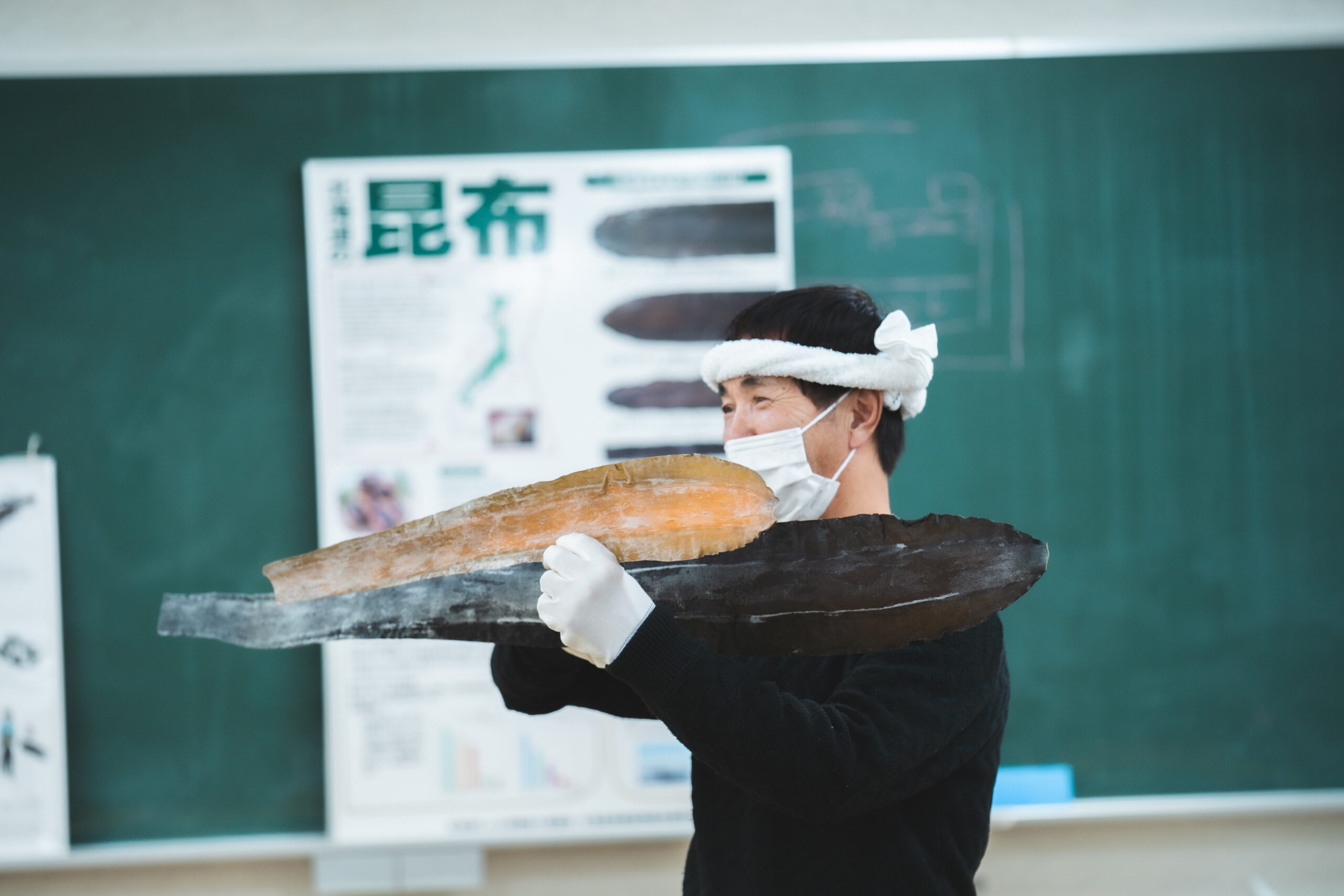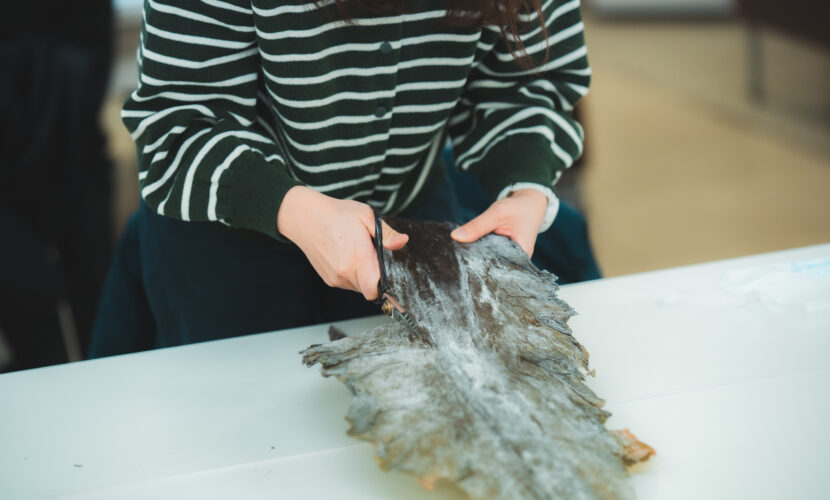取材:TRAVEL HOKKAIDO ピタ大畑
日本料理は海藻を使用することで有名です。海藻の種類はさまざまですが、昆布、干し海藻などはここのパントリーの定番です。 日本の昆布の 90% 以上が北海道産ですが、羅臼産の昆布は全体の 1~2% にすぎません。 羅臼の昆布は、日本で採れる昆布の中でもコクがあり、コクのある濃厚な出汁がとれることで知られています。
羅臼エリアは、知床半島周辺で唯一、昆布がとれる場所です。 根室海峡にあるこの狭い漁場には、豊かなうま味を育む素晴らしい天然資源があり、地元の漁師は自分たちの製品を信じられないほど誇りに思っています。 羅臼周辺の海は、流氷が運ぶプランクトン、知床連山の雪解け水から流れ込む豊富なミネラル、そしてそこに生息する動植物の循環など、独特の生態系を持っています。 それは、美味しい昆布製品だけでなく、多種多様な魚介類を生産するこの小さな海域につながります。
羅臼近海では天然昆布と養殖昆布が同じ海域で育っています。 どちらの品種も、収穫前にミネラル豊富な海で約 2 年間栽培されますが、養殖された昆布の種は、水面のすぐ下でロープに取り付けられます。 約 2cm の「子昆布」が一度枯れてから、2 メートル近くの完全な「成昆布」サイズに戻るには、丸 2 年かかります。 昆布を乾燥させてだしや出汁用の昆布にしたり、コクのある味わいと柔らかな食感からそのまま食することもできます。
あなたが私のように、日常の食事に海藻ベースをあまり使用しない国(イギリスは想像力豊かな食品の選択で正確には知られていない)の出身である場合、昆布の種類と用途についてもっと学ぶことは本当に興味深いことです。羅臼の漁師は、昆布の味の開発に熱心に取り組んでおり、収穫から出荷までのプロセスは、文字通り23工程という詳細な手順を地元で行っています。
もちろん、羅臼に来たら海の幸をいろいろ食べてみることも欠かせません。 しかし、プロセスを間近で理解するもう1つの優れた方法は、町で昆布切りのワークショップに参加することです。ここでは、地元の専門家から歴史と準備方法を直接学びます。カットを体験した後は、昆布を持ち帰ることができます。調理方法や使い方の説明書が満載です。
羅臼の昆布づくりの23工程を学ぶのはとても興味深いものでした。 美味しい食材があなたの手元に届くまでの旅の物語です。 毎年7月下旬から8月にかけて、海底から2歳の「成昆布」を長い道具でひねって摘み取ります。 その後、昆布を海水で洗い、小石の多い浜辺で2~3日干します。 昆布を移動させて根を切り、浜から集めた昆布を乾燥室に運びます。 その後、根元を露出させたまま覆いますが、日没後に浜辺に広げ、再び集めて丸め、一晩放置して風味を引き出すというプロセスを経ます。 そして、この時点では、プロセスの半分しか進んでいません。 これらの各ステップで使用されるツールは、ワークショップの一部として見ることができるので、ストーリーに命を吹き込むのに非常に役立ちます。
その後、昆布を伸ばして重しを加えて味を熟成させ、晴れた日にもう一度外に出して干します。 次に、昆布を集め、根を露出させて覆い、一晩重み付けするという手順が繰り返されます。 昆布を切る段階まで来たら、ワークショップの一環として自分自身の旅に足を踏み入れましょう。 昆布の両側が形に合わせてトリミングされており、簡単なように見えるものを試してみることができますが、うまくいくには少し練習が必要です. 昆布を格子状に重ねることで、風味がさらに引き立ちます。 最後に、昆布のさまざまな部分が梱包され、分類されます (昆布には 30 を超える等級があります)。出荷の準備が整います。
羅臼昆布の旅には、歴史とこだわり、そして地域の味が詰まっています。 地元の漁師がこの収穫物を貴重なものと見なしていることは明らかです。 私を驚かせるのは、ステップの正確さです。 昆布を適量干します。 昆布を湿らせます。 昆布は1枚1枚丁寧に伸ばしていきます。 準備のすべてのステップには、慎重さとゆったりとした素敵なものがあります。 羅臼昆布は、海藻の中でもグルタミン酸の含有量が最も高いといわれ、漁師自らが数十回の工程と熟成を経て育まれています。 それは食べ物をおいしくしますが、それは簡単なことでも当たり前のことでもありません。 これは、私たちが陥りがちなファストフード文化とは正反対です。 羅臼の昆布は、栄養豊富で栄養価の高い食品であり、丁寧に丁寧に生産、収穫、調理されています。 急いでいるわけではありません。毎年、この漁業コミュニティで行われているプロセスを見るのはとても魅力的です。
ワークショップでは、最も有名な昆布の 1 つである最もおいしいだしの作り方について質問する機会があります。 昆布は和食の重要な調味料であり、うま味の重要な源です。 切ったばかりの羅臼昆布を家に持ち帰るときは、水またはコンロで準備しているスープにいくつかの部分を追加するか、一晩水に浸して冷やします。根室海峡の昆布ならではの濃厚な味わいを、この大切な地域で過ごした思い出に。
羅臼での昆布切りワークショップの所要時間は約 1.5 時間で、この地域への次の旅行におすすめです。



